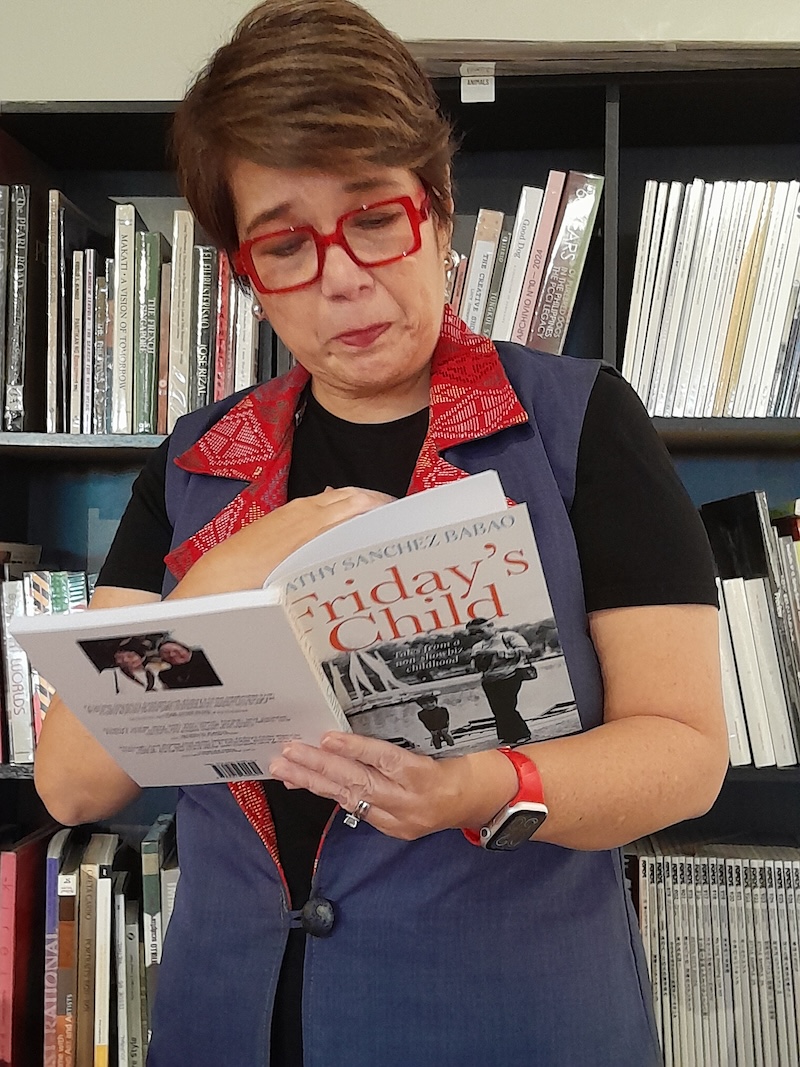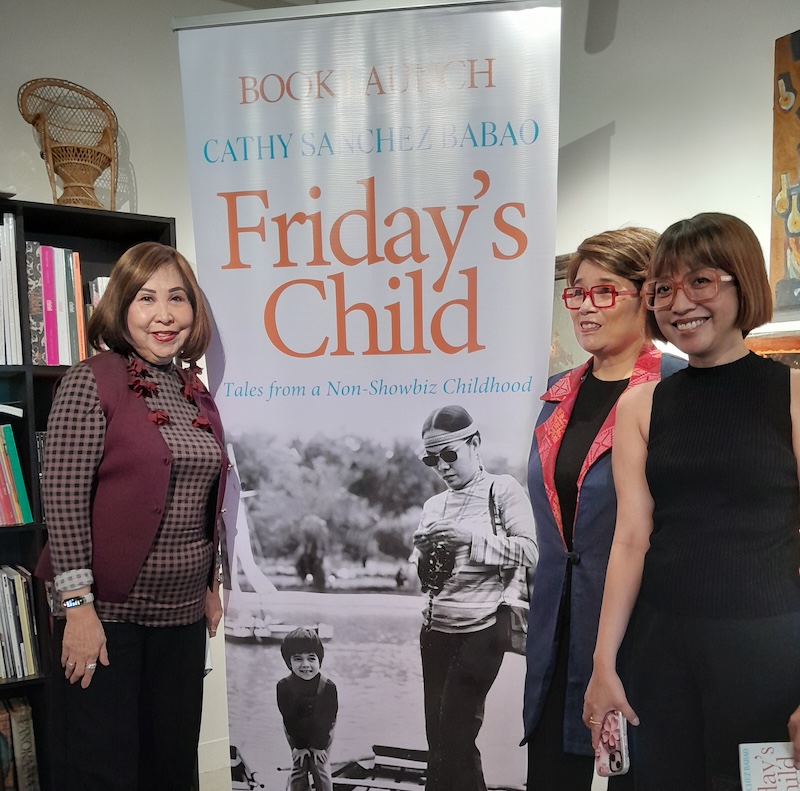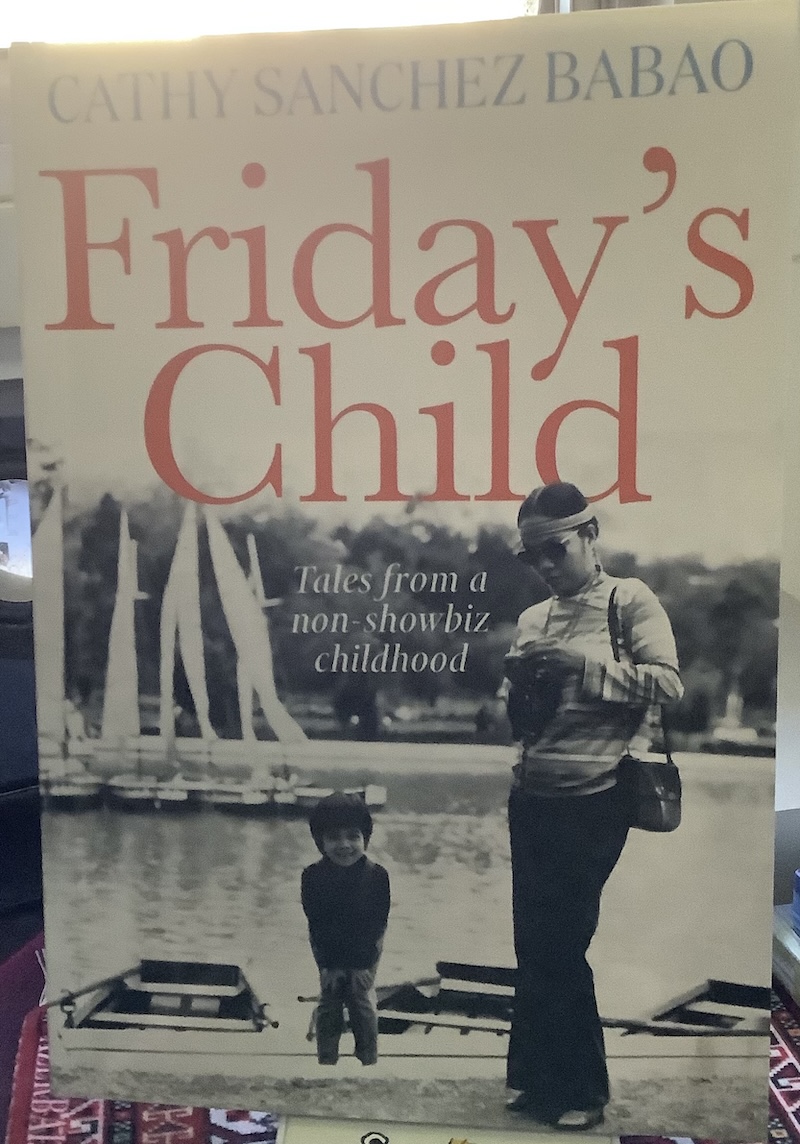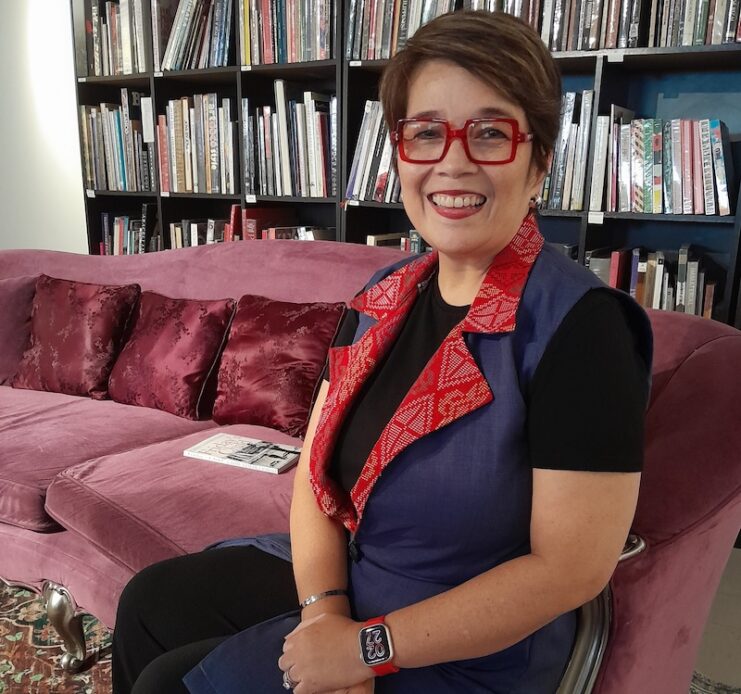All photos by Elizabeth Lolarga
In the world of celebrity queendom, author Cathy Sanchez Babao has lived with the appendage “daughter of Caridad Sanchez” for as long as she can remember. Now the daughter of the esteemed actor has come up with Friday’s Child: Tales from a Non-showbiz Childhood, a memoir featuring her as a child with her mother on the cover on the dock of Burnham Lake, Baguio City, in the days when the boats had real sails.

Cathy Sanchez Babao gets emotional as she reads about her mother Caridad.
My earliest memory of Cathy and Caridad was when Cathy took ballet lessons in my school, St. Paul College Quezon City, with Bonnie Weinstein-Calagopi. Caridad would stay in the waiting area with the other mothers. The lessons took place after school hours. She would either be fastidiously crocheting or regaling the young moms with stories of her kapwa artista (fellow actors). Her hair hung loosely and long, and was well-brushed.

Publisher Joy Buensalido, Cathy Sanchez Babao and her former Inquirer Lifestyle editor Cheche Moral
The short essays comprising the memoir, Cathy has already been posting on her Facebook the past two to three years. She launched this book, published by Buensalido Public Relations Agency, recently at Archivo 1984 Gallery in Makati, a setting so intimate and with a select crowd of people dear to her, beginning with her children Pia and Leon.
But I was surprised when, in the middle of her short talk, she wept openly, such that PR maven Joy Buensalido had to hand her some tissues. Asked why the tears on such a happy occasion, Cathy answered, “Those tears were primarily for my mom. For the little girl I once was, sitting beside her in the car as she drove, or on quiet afternoons while she told stories that made me laugh until I couldn’t breathe. And I guess also, for the woman I became, finally finding the courage to write them down.”
She continued, “They were for all the years I spent holding on to those memories, unsure if anyone else would see their worth. For the moments now when I miss the way she used to be, and for the joy of realizing that through the stories in this book, how she was, she lives again. Her humor, her quirks, her stubborn grace, all bound in pages that will outlast both of us. I suppose at that moment, standing there with the book in my hands, I felt it: grief and gratitude holding hands. The circle is complete. My tears weren’t just sorrow; they were thanksgiving. For the life she lived, the stories she left me, and the grace that allowed me to finally share her with the world. So yes, those tears were for her. But they were also for all of us who keep loving, even in the midst of a long goodbye.”
The bulk of the essays were written in the US between May and July this year. She explained, “My life in the US is much quieter than my life in Manila. The days are much simpler, with routines in place. I spend most of my time there writing and catching up on reading. Wala masyadong (there is not much) distraction there.” She is married to American Mark Philbrick, who couldn’t attend the book launch because he was down with a flu bug.
Meanwhile, she, Joy, and I had been talking about doing a book together for about two years already. They decided that Friday’s Child would be a good one to release this year.
Asked who her favorite writers are and if inevitably they are women, she said, “In school I read a lot of Carmen Guerrero Nakpil’s essays. Her essays model what it meant to be a thinking Filipino woman in the mid-20th century—graceful, articulate, assertive. She often dissected gender expectations with quiet authority and insight.”
She added, “Over the past several years I’ve been reading a lot of Anne Lamott and Elissa Altman’s essays. I love Lamott’s writing style—intimate, funny, self-deprecating, and profoundly spiritual. She writes about faith, grief, family, addiction, writing, and the messy beauty of being human, with a voice that is both vulnerable and wise. Altman blends the emotional depth of memoir with the precision of literary prose. When she writes about grief or loss, her pieces have an elegant narrative arc: a beginning grounded in vivid imagery, a middle that explores emotional tension, and a closing that offers insight or release.”
She views writing as something that “begins not with words but with attention. Before I sit down to write, I try to listen. To the rhythm of a morning walk, the clinking of coffee cups, the faint sound of my own breath. These small rituals help me slow down enough to notice. That’s often where the first line finds me: in the quiet.”
‘Before I sit down to write, I try to listen….’
Cathy describes her writing habits as simple. “I write early, when the world still feels soft, before the noise of the day sets in. I keep a notebook nearby to catch fleeting thoughts or phrases, because the ones that come uninvited are usually the truest. I will rewrite or edit later. I try not to strip the emotion out of a sentence in my quest for perfection. Writing, for me, is part meditation and part excavation. It’s my way of making sense of what memory leaves behind.
“I honed my skills by reading everything I could get my hands on—memoirs, books on grief, psychology, history, spirituality, novels, short story collections, the occasional novel, even old letters tucked inside my mother’s drawers. I learned rhythm from poetry, honesty from memoir, and restraint from silence. Over time, I found that my voice lived somewhere between grief and gratitude, humor and faith.
“What taught me most, though, was life itself: losing people I loved, raising my children, growing older, forgiving myself. Writing through those seasons taught me that stories heal when they are shared with humility and heart.”
She compares her writing to the way one tends a garden: “with patience, reverence and a quiet hope that something beautiful might bloom, even from what once felt broken.”
Cathy is also a grief counselor. I was curious how she shakes off the “heaviness” at the end of a session. She replied, “After every grief session, often there’s a stillness that follows. Like a quiet weight that lingers in the room. I’ve learned not to rush that moment. I sit with it for a few minutes, acknowledging the sacredness of what was shared. Bearing witness to another person’s grief is an act of deep trust, and it deserves a small pause before I move on.
“Taking deep breaths when the case is especially heavy helps a lot. Slowly. Intentionally.
Sometimes I find the need to step outside, feel the sun on my face, or let the wind carry a bit of that heaviness away. Other times, I will wash my hands under running water, not just as a ritual of cleansing, but as a physical reminder that I can release what isn’t mine to carry.”
She also said, “Music helps. I may listen to a familiar song, something gentle and grounding. It helps shift the energy. Often, I will make myself a cup of tea and sit back while listening to music. These small, ordinary acts tether me back to life’s rhythm, reminding me that the world, despite its sorrows, continues to hold beauty. I’ve also learned the importance of boundaries, of not confusing empathy with absorption. At the close of the day, I’ll whisper a quiet prayer of gratitude for the people I encountered that day. I thank God for their courage, for the grace that allows healing to begin and for the privilege of walking alongside them, even for a moment. That’s how I shake off the heaviness, not by forgetting but by honoring it, then gently letting it go.”

Cathy Sanchez Babao’s book of memories
As for publisher Joy, she decided on collaborating with Cathy because the latter’s works are the kind she looks for—“personal but very meaningful stories, full of vivid memories, heartfelt and charming but possessing a quiet but firm power that can’t help but draw you in.”
Copies of ‘Friday’s Child’ are available at the PR agency office at Suite 701, seventh floor, Greenbelt Mansion, 106 Perea Street, Legaspi Village, Makati City, or email books@buensalido.com.ph. Call or text Tina Allarey at Viber +63920-954-2980.





